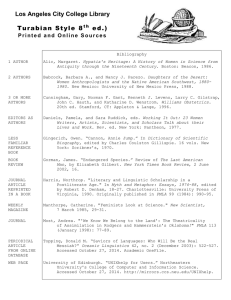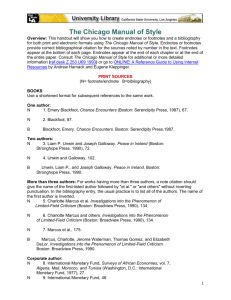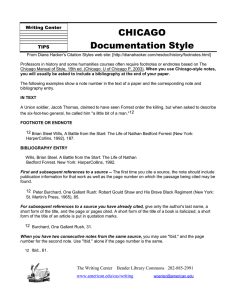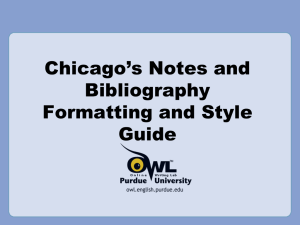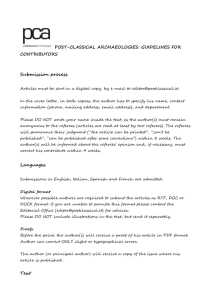CHICAGO MANUAL OF STYLE - CITING PRINT SOURCES
advertisement
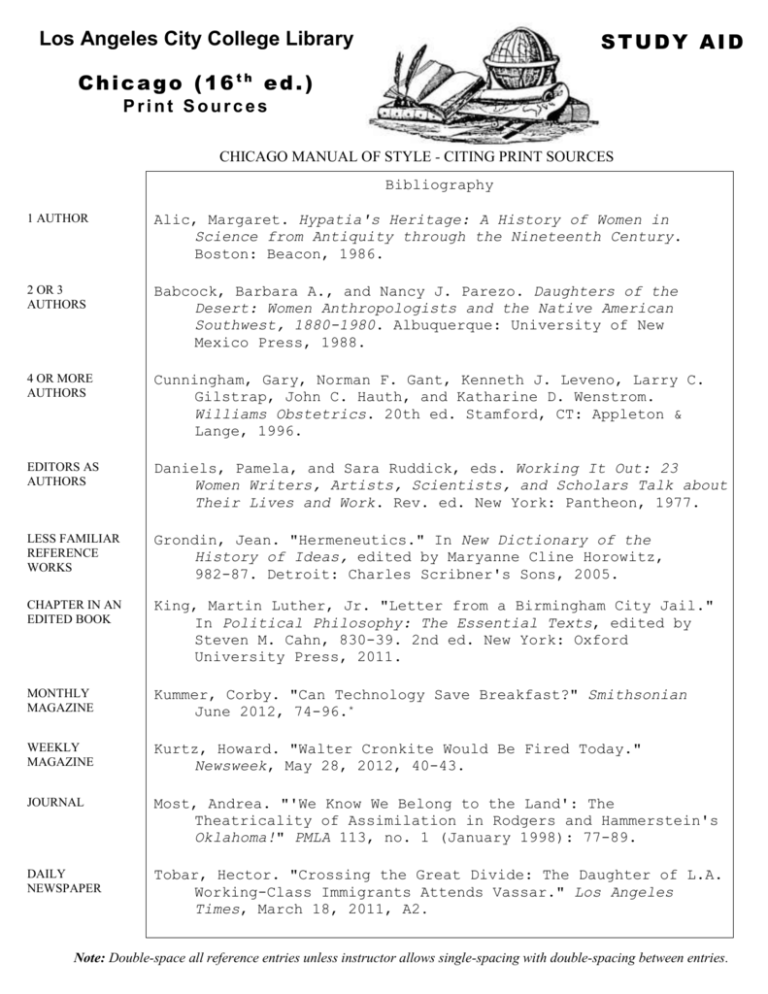
STUDY AID Los Angeles City College Library Chicago (16th ed.) Print Sources CHICAGO MANUAL OF STYLE - CITING PRINT SOURCES Bibliography 1 AUTHOR Alic, Margaret. Hypatia's Heritage: A History of Women in Science from Antiquity through the Nineteenth Century. Boston: Beacon, 1986. 2 OR 3 AUTHORS Babcock, Barbara A., and Nancy J. Parezo. Daughters of the Desert: Women Anthropologists and the Native American Southwest, 1880-1980. Albuquerque: University of New Mexico Press, 1988. 4 OR MORE AUTHORS Cunningham, Gary, Norman F. Gant, Kenneth J. Leveno, Larry C. Gilstrap, John C. Hauth, and Katharine D. Wenstrom. Williams Obstetrics. 20th ed. Stamford, CT: Appleton & Lange, 1996. EDITORS AS AUTHORS Daniels, Pamela, and Sara Ruddick, eds. Working It Out: 23 Women Writers, Artists, Scientists, and Scholars Talk about Their Lives and Work. Rev. ed. New York: Pantheon, 1977. LESS FAMILIAR REFERENCE WORKS Grondin, Jean. "Hermeneutics." In New Dictionary of the History of Ideas, edited by Maryanne Cline Horowitz, 982-87. Detroit: Charles Scribner's Sons, 2005. CHAPTER IN AN EDITED BOOK King, Martin Luther, Jr. "Letter from a Birmingham City Jail." In Political Philosophy: The Essential Texts, edited by Steven M. Cahn, 830-39. 2nd ed. New York: Oxford University Press, 2011. MONTHLY MAGAZINE Kummer, Corby. "Can Technology Save Breakfast?" Smithsonian June 2012, 74-96.* WEEKLY MAGAZINE Kurtz, Howard. "Walter Cronkite Would Be Fired Today." Newsweek, May 28, 2012, 40-43. JOURNAL Most, Andrea. "'We Know We Belong to the Land': The Theatricality of Assimilation in Rodgers and Hammerstein's Oklahoma!" PMLA 113, no. 1 (January 1998): 77-89. DAILY NEWSPAPER Tobar, Hector. "Crossing the Great Divide: The Daughter of L.A. Working-Class Immigrants Attends Vassar." Los Angeles Times, March 18, 2011, A2. Note: Double-space all reference entries unless instructor allows single-spacing with double-spacing between entries. CITING SOURCES WITHIN YOUR PAPER The following guidelines and examples are based on the 16th edition of the Chicago Manual of Style (R 808.027 C432m16 ) and “Chicago-Style Citation Quick Guide” (http://www.chicagomanualofstyle.org/tools_citationguide.html). If you have additional questions, please refer to the above texts, consult your professor, or ask one of our friendly Librarians for help. The Chicago Manual of Style presents two basic documentation systems: 1. Notes-bibliography system (footnotes or endnotes, and bibliography). 2. Author-date system (in-text citations matched by reference list entries). This study aid reflects the notes-bibliography system, in which each quoted or paraphrased material is marked numerically as a superscript in the text. Each number relates to a note at the bottom of the page (footnotes) or at the end of the paper (endnotes). Here are some basic rules: To acknowledge a source in your paper, place an arabic numeral typed slightly above the line (superscript) at the end of the quote or paraphrase. Note numbers must follow one another in numerical order, beginning with 1. Note generally lists the author, title, and facts of publication, in that order. Elements are separated by commas; the facts of publication are enclosed in parentheses. Authors’ names are presented in standard order (first name first). Double spacing is recommended throughout the entire paper, including notes and bibliography (unless your professor specifies otherwise). First line of a note should be indented five spaces from the left margin. The first time a work is mentioned in a note, the entry should be in complete form. Once a work has been cited in full, subsequent references to it should be in shortened form (see examples below). When references to the same work follow one another with no intervening references, “ibid.” may take the place of the author’s name, title of the work and any succeeding material that is identical. (Ibid. is an abbreviation of the Latin word ibidem, “in the same place”). Refer to the page by number at the end of the note. Well-known reference books are normally cited in notes rather than in bibliographies. The facts of publication are often omitted, but the edition (if not the first) must be specified. References to an alphabetically arranged work cite the item (not the volume or page number) preceded by “s.v.” (from Latin sub verbo, “under the word”). For four or more authors, list all of the authors in the bibliography; in the note, list only the first author, followed by “et al.” (from Latin et aliae or et alii “and others”). Sample Entries for Footnote References 1. Margaret Alic, Hypatia's Heritage: A History of Women in Science from Antiquity through the Nineteenth Century (Boston: Beacon, 1986), 45. Subsequent reference to the same work, different page number: 2. Ibid., 14. Shortened (not subsequent) reference: 3. Alic, Hypatia's Heritage, 25. Popular magazine article: 4. Steve Martin, “Sports-Interview Shocker,” New Yorker, 6 May 2002, 84. Journal article: 5. John Maynard Smith, “The Origin of Altruism,” Nature 393 (1998): 639–40. Article in well-known reference book (no need to list in Bibliography): 6 . Encyclopaedia Britannica, 15th ed., s.v. “salvation.” Chapter or other part of a book: 7. Martin Luther King, Jr., "Letter from a Birmingham City Jail," in Political Philosophy: The Essential Texts, 2nd ed., ed. Steven M. Cahn (New York: Oxford University Press, 2011), 831. R e v i s e d D e c e m b e r 2 0 1 2 b y B . V a s q u e z , E . Gn e r r e a n d A. M e z y n s k i
